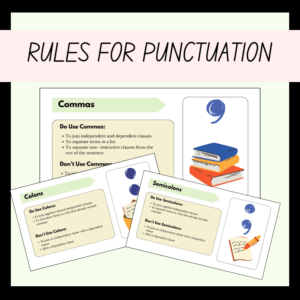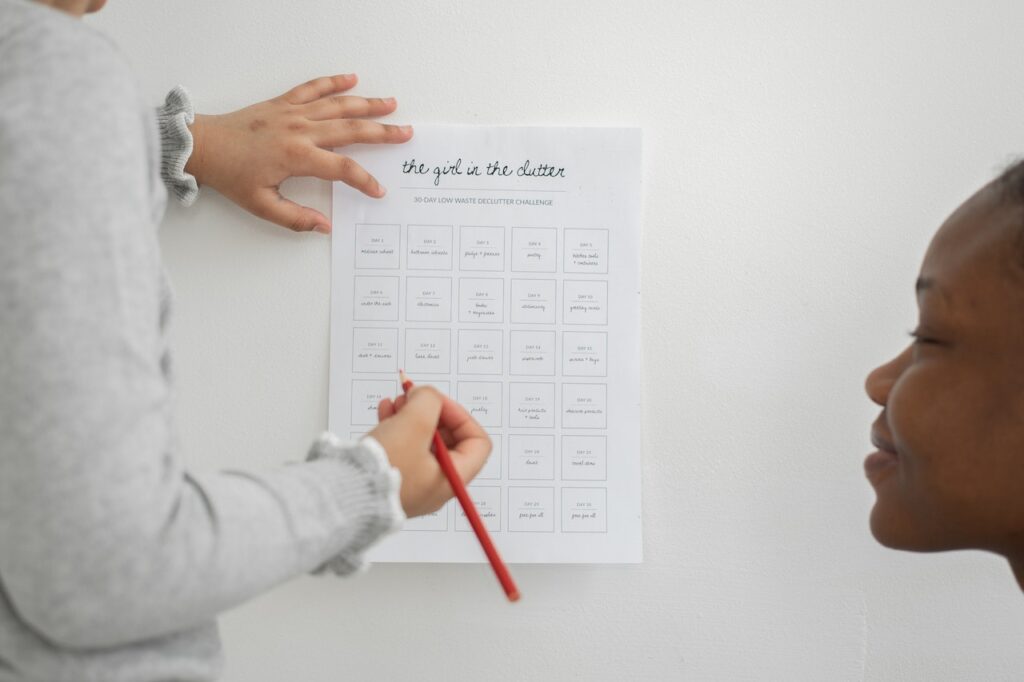Our easy guide to teaching the writing process will help make planning homeschool lessons easier with this resource that includes: step-by-step ways to complete the process. We have included a colorful hamburger styled poster that highlights the steps that parents love!
Why Should You Use Our Teaching Resources?
Teaching English Language Arts (ELA) at home can feel like a challenging task, especially when it comes to guiding your child through the writing process. However, with the right approach and tools, you can make writing an engaging and rewarding experience for your child. This guide will walk you through teaching the steps to the writing process, understanding story elements, and mastering punctuation—all essential components of a solid ELA curriculum.
1. Teaching the Steps to the Writing Process (A Presentation Guide)
Understanding the writing process is key to helping your child become a confident and effective writer. The writing process can be broken down into five main stages: Prewriting, Drafting, Revising, Editing, and Publishing.

Step-by-Step Approach:
Let’s now take a look at our step by step approach to the writing process.

Prewriting (or Planning):
Start by encouraging your child to brainstorm ideas. This can be done through mind mapping, listing, or simply discussing topics of interest. Ask open-ended questions to help them explore different angles of a topic. The goal is to gather as many ideas as possible without worrying about organization or correctness.

Drafting:
Once your child has chosen a topic and gathered ideas, it’s time to start drafting. Encourage them to write freely, focusing on getting their thoughts down on paper. Remind them that this is not the final version, so they don’t need to worry about grammar or punctuation just yet. The aim here is to create a rough version of their work.

Sharing:
After the drafting stage, have your child share their inital story guide (or first draft) in order to get constructive and creative feedback on what is written so far, and what can be added to the story line.

Evaluating:
At this stage, the writer can self reflect on how the story is coming together. Taking the time for self-reflection will help bring out more creative approaches to the words already written.

Revising:
After evaluating, take a break before revising. During revision, guide your child to further improve their second draft by adding details, rearranging ideas, and clarifying concepts. Encourage them to read their work aloud, which can help them catch awkward phrasing and identify areas that need more detail.

Editing:
In this stage, focus on grammar, punctuation, and spelling. You can use checklists to help your child go through their work systematically, correcting any errors. This step is about polishing the writing to make it as clear and error-free as possible.

Publishing:
Finally, let your child publish their work. This could mean writing a final copy, typing it up, or even sharing it with family members or in a homeschool co-op. Publishing gives a sense of accomplishment and provides a real audience for their writing.

2. Exploring Elements of Story Writing
Understanding the elements of a story is crucial for creating engaging narratives. Key elements include setting, characters, plot, conflict, and resolution.

Breaking Down the Elements:

**Setting:**
Discuss with your child the importance of the setting in a story. Where and when does the story take place? How does the setting influence the characters and events? Use examples from favorite books or movies to illustrate how a well-developed setting enhances a story.
**Characters:**
Characters are the heart of any story. Help your child develop their characters by thinking about their personalities, motivations, and how they change over the course of the story. You can use character worksheets or ask questions like, “What does this character want?” and “What challenges do they face?”
**Plot:**
The plot is the sequence of events in a story. Introduce the concept of a plot diagram, which includes the introduction, rising action, climax, falling action, and resolution. Have your child practice outlining the plot of a story they read recently or one they plan to write.
**Conflict:**
Conflict drives the plot and keeps readers engaged. Discuss different types of conflict (e.g., character vs. character, character vs. self, character vs. society, character vs. nature) and how they create tension in a story. Encourage your child to identify conflicts in stories they know and to create conflicts in their own writing.
**Resolution:**
The resolution (or conclusion) is how the story’s conflict is resolved. It’s important for the resolution to be satisfying and logical. Ask your child to think about how their story’s conflict can be resolved in a way that feels true to the characters and the plot.

3. Mastering Punctuation
Punctuation is essential for clear communication in writing. It helps convey meaning, indicates pauses, and separates ideas. Teaching punctuation can be simple with a step-by-step approach.

– **Periods, Exclamation Points, and Question Marks:** Start with the basics of sentence endings. Explain the different uses of periods, exclamation points, and question marks. Use examples from books or have your child create their own sentences using each type.
– **Commas:** Teach your child how to use commas in lists, after introductory phrases, and to separate clauses. Practice by writing sentences together and adding commas where needed. Use fun activities like comma quizzes or sentence rewriting to reinforce these rules.
– **Quotation Marks:** Show how quotation marks are used for dialogue. Practice by writing short conversations and using quotation marks correctly. Explain how commas and periods are placed inside quotation marks, while question marks and exclamation points depend on the context.
– **Apostrophes:** Discuss the use of apostrophes in contractions (e.g., don’t, can’t) and possessives (e.g., Sarah’s book, the dog’s leash). Create worksheets or simple exercises where your child can practice using apostrophes in different contexts.
Tips for Successful ELA Homeschooling
– **Incorporate Fun Activities:** Use games, story prompts, and interactive activities to make learning enjoyable. For example, use the **Hamburger-Themed Elements to Story Writing Poster** as a fun visual tool to teach story structure.
– **Encourage Reading:** Reading widely can help your child understand different writing styles, story structures, and proper punctuation usage. Make reading a daily habit and discuss books together.
– **Practice Regularly:** Consistent practice is key to mastering writing skills. Set aside dedicated time for writing each day or week. Encourage your child to keep a journal, write letters, or create stories.
– **Provide Feedback:** Offer constructive feedback on your child’s writing. Focus on both strengths and areas for improvement. Use positive reinforcement to build confidence.
– **Use Resources:** Utilize resources like writing guides, worksheets, and educational websites. There are many free and affordable tools available that can help supplement your homeschool curriculum.

Writing Tools For Homeschooling Students
This blog contains Amazon affiliate links to highlighted products. By clicking on the links and making a purchase we may earn a small commission at no extra cost to you. Click here for full disclosure.
Here are 5 helpful writing tools available on Amazon to support homeschooling students with writing:
- Handwriting Practice Workbooks
- Great for younger learners to improve letter formation, spacing, and handwriting fluency.
Example: “Learning Without Tears: Handwriting Without Tears Workbook.“
- Great for younger learners to improve letter formation, spacing, and handwriting fluency.
- Story Cubes or Writing Prompts Cards
- Tools like story cubes or prompt cards encourage creative storytelling and idea generation.
Example: “Rory’s Story Cubes” or “500 Writing Prompts for Kids.“
- Tools like story cubes or prompt cards encourage creative storytelling and idea generation.
- Dry-Erase Writing Boards
- Reusable boards help students practice spelling, sentence structure, and handwriting without wasting paper.
Example: “Magnetic Dry Erase Handwriting Board for Kids.”
- Reusable boards help students practice spelling, sentence structure, and handwriting without wasting paper.
- Graphic Organizers for Writing
- Visual templates that help students plan essays, stories, and paragraphs.
Example: “Scholastic Graphic Organizers for Writing.“
- Visual templates that help students plan essays, stories, and paragraphs.
- Grammar and Style Guides for Kids
- Age-appropriate books that teach grammar, punctuation, and writing techniques in a fun way.
Example: “The Writing Revolution” or “Eats, Shoots & Leaves: Why, Commas Really Do Make a Difference!“
- Age-appropriate books that teach grammar, punctuation, and writing techniques in a fun way.
These tools make writing engaging, structured, and accessible for homeschooling students.
Related Topics
- English language arts worksheets available on Canva
- English language teaching guides available through our TpT store
- Teach English language learning at home
- The basics of language learning
- Why Hooked on Phonics is popular with homeschooling parents
- The benefits of journal writing at home
- How to write a persuasive essay
- How to write a compare-contrast essay
- ELA Rubrics for the Homeschool Classroom
- Easy Grammar Activities for Homeschooling Students
Join our Community!
Join our growing list of homeschooling parents and get access to amazing resources like these for your homeschool classroom!
Final Thoughts
Teaching the writing process, story elements, and punctuation in a homeschool setting doesn’t have to be overwhelming. By breaking down each concept into manageable steps and using engaging, creative methods, you can help your child develop strong writing skills. With patience, practice, and the right resources, your child can become a confident writer who enjoys the art of storytelling. Happy homeschooling!
Share Your Thoughts!
EduKitchen would like to hear from you. Leave us a comment below on the your thoughts about using our approach to the writing process in the homeschooling classroom.




